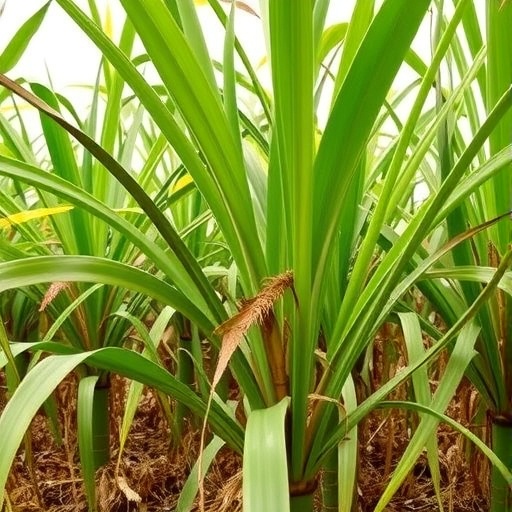In a groundbreaking study that could reshape the future of biofuel production, researchers have unveiled the biotechnological potential of an enzyme known as β-glucosidase sourced from the fungus Rasamsonia composticola. This enzyme exhibits remarkable glucose tolerance, making it an invaluable ally in the saccharification process of sugarcane bagasse—an abundant agricultural waste product. As the world seeks more sustainable energy solutions, this discovery places sugarcane biomass at the forefront of renewable energy production.
The research, conducted by Vargas, I.P., Galeano, R.M.S., and de Almeida, A.P., delves deeply into the characteristics and applicability of β-GluRc, the glucose-tolerant β-glucosidase. The scientists meticulously analyzed the enzyme’s behavior under different conditions, elucidating its potential in converting complex carbohydrates found in biomass into simpler sugars. This transformation is a critical step in bioethanol production, where the fermentation of sugars results in potential energy sources.
One of the standout features of β-GluRc is its glucose tolerance, a trait that distinguishes it from many other glycoside hydrolases. Typically, high concentrations of glucose can inhibit enzymatic activity, adversely affecting sugar conversion efficiencies in fermentation processes. However, β-GluRc shows resilience against such inhibition. This characteristic dramatically enhances the enzyme’s utility in industrial applications, particularly in scenarios involving high-glucose environments, like the saccharification of sugarcane bagasse.
Sugarcane bagasse, the fibrous residue remaining after juice extraction, is often underutilized despite being a significant byproduct of sugar production. Traditionally considered waste, its high cellulose and hemicellulose content makes it a prime candidate for bioethanol production, a renewable energy source that can mitigate the reliance on fossil fuels. The ability of β-GluRc to effectively convert this biomass into fermentable sugars aligns perfectly with global sustainability goals and centuries-old challenges faced by the biofuel industry.
The enzyme’s performance was rigorously compared with that of other commercially available β-glucosidases in various settings, revealing its superior capacity to accelerate hydrolysis while maintaining activity in the presence of glucose. This advancement could lead to more efficient processes, reducing the technological and economic barriers currently plaguing bioethanol production, especially in developing regions where sugarcane is cultivated extensively.
Furthermore, the researchers explored the operational parameters influencing the effectiveness of β-GluRc. They investigated temperature, pH, and reaction time, determining the optimal conditions under which the enzyme operates at peak efficiency. These insights are critical for scaling up the enzyme’s application to industrial levels, ensuring that bioethanol production processes are both cost-effective and environmentally friendly.
The bioengineering of β-glucosidases has entered a new era, spurred by advances in genomic and proteomic technologies. The team behind this study utilized cutting-edge methodologies to isolate and characterize the β-GluRc enzyme from Rasamsonia composticola. Their research contributes not only to our understanding of this specific enzyme but to the broader scientific community’s knowledge of how microbial diversity can be harnessed for biotechnological applications.
An exciting expectation from this research is its potential impact on the global renewable energy market. With bioethanol being a crucial player in the renewable energy landscape, any improvements in the efficiency of its production methods could translate to significant shifts in energy policy and economic stability, particularly in countries heavily reliant on agriculture and raw biomass as an energy source.
The results of this research have implications far beyond the laboratory. Implementing technology that utilizes β-GluRc could minimize waste and promote sustainable agricultural practices. This aligns with the rising consumer demand for eco-friendly energy solutions, serving as a catalyst for innovation and investment in sustainable technologies.
In addition to its implications for biofuel production, the study highlights the ongoing importance of enzyme research in solving global challenges related to waste management and energy conservation. With the world wrestling with climate change and the urgent need for cleaner energy, enzymes like β-GluRc could pave the way toward a more sustainable future.
The research has already garnered interest from both industrial players and academic circles. As the biofuel industry looks to diversify and innovate, beta-glucosidases such as β-GluRc present a unique opportunity to reshape production paradigms and enhance energy efficiency. The next steps for the research team involve collaborative projects with industry leaders to bring these findings from the lab to the field, translating the enzyme’s potential into real-world applications.
In summary, the discovery of the glucose-tolerant β-glucosidase from Rasamsonia composticola, with its promising applicability in sugarcane bagasse saccharification, could herald a shift in renewable energy strategies worldwide. This study not only sheds light on a potent biocatalyst but also represents a step toward sustainable biofuel production grounded in scientific innovation and agricultural byproduct utilization.
With continued research and development, the catalytic advances showcased by β-GluRc might be the key to unlocking vast reserves of energy hidden in agricultural waste, ensuring that our transition to renewable energy sources is both innovative and effective.
Subject of Research: The biotechnological potential of glucose-tolerant β-glucosidase from Rasamsonia composticola in sugarcane bagasse saccharification.
Article Title: Biotechnological Potential of a Glucose-Tolerant β-Glucosidase from Rasamsonia composticola (β-GluRc) in Sugarcane Bagasse Saccharification.
Article References:
Vargas, I.P., Galeano, R.M.S., de Almeida, A.P. et al. Biotechnological Potential of a Glucose-Tolerant β-Glucosidase from Rasamsonia composticola (β-GluRc) in Sugarcane Bagasse Saccharification. Waste Biomass Valor (2025). https://doi.org/10.1007/s12649-025-03374-1
Image Credits: AI Generated
DOI: https://doi.org/10.1007/s12649-025-03374-1
Keywords: β-glucosidase, Rasamsonia composticola, glucose tolerance, sugarcane bagasse, bioethanol production, sustainable energy, renewable resources.




